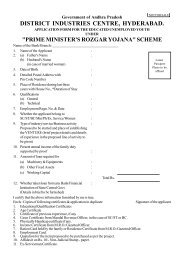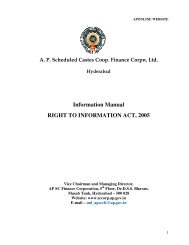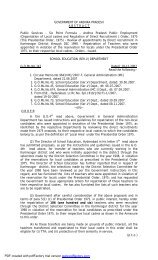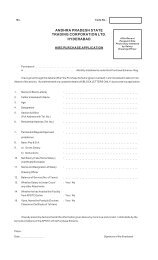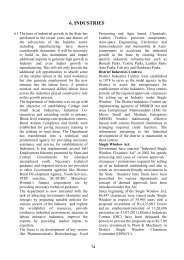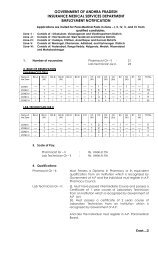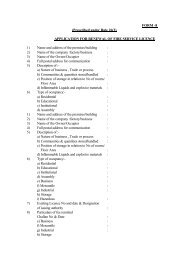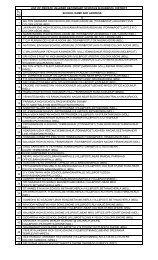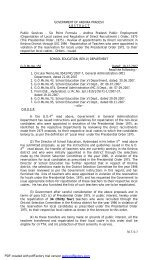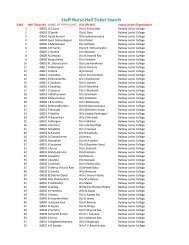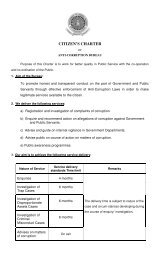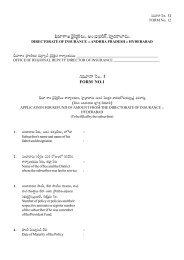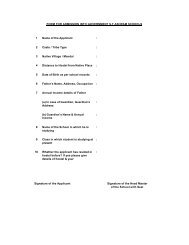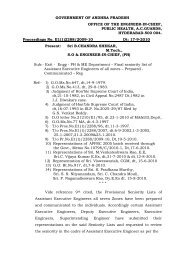- Page 1 and 2:
For official use only ANDHRA PRADES
- Page 3 and 4:
2 DECISION - S.No. Name of Case Cit
- Page 5 and 6:
4 DECISION - S.No. Name of Case Cit
- Page 7 and 8:
6 DECISION - S.No. Name of Case Cit
- Page 9 and 10:
8 DECISION - S.No. Name of Case Cit
- Page 11 and 12:
10 DECISION - S.No. Name of Case Ci
- Page 13 and 14:
12 DECISION - S.No. Name of Case Ci
- Page 15 and 16:
14 DECISION - S.No. Name of Case Ci
- Page 17 and 18:
16 DECISION - S.No. Name of Case Ci
- Page 19 and 20:
18 DECISION - S.No. Name of Case Ci
- Page 21 and 22:
20 DECISION - S.No. Name of Case Ci
- Page 23 and 24:
22 DECISION - S.No. Name of Case Ci
- Page 25 and 26:
24 DECISION - S.No. Name of Case Ci
- Page 27 and 28:
26 DECISION - S.No. Name of Case Ci
- Page 29 and 30:
28 DECISION - S.No. Name of Case 52
- Page 31 and 32:
30 DECISION -
- Page 33 and 34:
32 DECISION - 29. C.B.I. report —
- Page 35 and 36:
34 DECISION - 86. Conviction — su
- Page 37 and 38:
36 DECISION - 141. Disproportionate
- Page 39 and 40:
38 DECISION - 195. Evidence — sta
- Page 41 and 42:
40 DECISION - 253. Judgment — tak
- Page 43 and 44:
42 DECISION - 311. P.C. Act, 1988
- Page 45 and 46:
44 DECISION - 369. Principles of na
- Page 47 and 48:
46 DECISION - 423. Sentence — ade
- Page 49 and 50:
48 DECISION - 480. Trap — investi
- Page 51 and 52:
50 DECISION -
- Page 53 and 54:
52 DECISION - 11. Adverse remarks 1
- Page 55 and 56:
54 DECISION - 27. Bribe-giver — p
- Page 57 and 58:
56 DECISION - 16. State of Madhya P
- Page 59 and 60:
58 DECISION - 60. Circumstantial ev
- Page 61 and 62:
60 DECISION - 367.Union of India vs
- Page 63 and 64:
62 DECISION - 78. Constitution of I
- Page 65 and 66:
64 DECISION - 115. Bhagwat Parshad
- Page 67 and 68:
66 DECISION - 520. Sheel Kumar Chou
- Page 69 and 70:
68 DECISION - 98. Defence evidence
- Page 71 and 72:
70 DECISION - 296.Kamruddin Pathan
- Page 73 and 74:
72 DECISION - 110. Departmental act
- Page 75 and 76:
74 DECISION - 503.High Court of jud
- Page 77 and 78:
76 DECISION - 70. Sajjan Singh vs.
- Page 79 and 80:
78 DECISION - 521.State vs. S. Bang
- Page 81 and 82:
80 DECISION - 129.K. Srinivasarao v
- Page 83 and 84:
82 DECISION - 318. B. Karunakar vs.
- Page 85 and 86:
84 DECISION - 188. Evidence — ext
- Page 87 and 88:
86 DECISION - 440. High Court of ju
- Page 89 and 90:
88 DECISION - 214. I.P.C. — Sec.
- Page 91 and 92:
90 DECISION - 468.B.Venkateswarulu
- Page 93 and 94:
92 DECISION - 255.Shivaji Atmaji Sa
- Page 95 and 96:
94 DECISION - 238. Inquiry report
- Page 97 and 98:
96 DECISION - 253. Judgment — tak
- Page 99 and 100:
98 DECISION - 267. Misconduct — a
- Page 101 and 102:
100 DECISION - 372.S.B. Ramesh vs.
- Page 103 and 104:
102 DECISION - 168.Natarajan vs. Di
- Page 105 and 106:
104 DECISION - 303. Order — in cy
- Page 107 and 108:
106 DECISION - 388.Rajasingh vs. St
- Page 109 and 110:
108 DECISION - 418.State of Maharas
- Page 111 and 112:
110 DECISION - 231.R.S. Nayak vs. A
- Page 113 and 114:
112 DECISION - 115. Bhagwat Parshad
- Page 115 and 116:
114 DECISION - 343. Penalty — red
- Page 117 and 118:
116 DECISION - 265.Udaivir Singh vs
- Page 119 and 120:
118 DECISION - 123.A.K. Kraipak vs.
- Page 121 and 122:
120 DECISION - 329.Union of India v
- Page 123 and 124:
122 DECISION - 392. Reasonable oppo
- Page 125 and 126:
124 DECISION - 412. Revision / Revi
- Page 127 and 128:
126 DECISION - 418. Sanction of pro
- Page 129 and 130:
128 DECISION - 201.Hazari Lal vs. S
- Page 131 and 132:
130 DECISION - 445. Suspension —
- Page 133 and 134:
132 DECISION - 456. Suspension —
- Page 135 and 136:
134 DECISION - 300. Shesh Narain Aw
- Page 137 and 138:
136 DECISION - 476. Trap — legiti
- Page 139 and 140:
138 DECISION - 201.Hazari Lal vs. S
- Page 141 and 142:
140 DECISION - 522. Madhukar Bhaska
- Page 143 and 144:
142 DECISION - 523.M.Narsinga Rao v
- Page 145 and 146:
144 DECISION - 526. Witnesses — r
- Page 147 and 148:
146 DECISION -
- Page 149 and 150:
148 DECISION - 3. For a Digest of C
- Page 151 and 152:
150 DECISION - to the High Court of
- Page 153 and 154:
152 DECISION - assets, on acquittal
- Page 155 and 156:
154 DECISION - termination of contr
- Page 157 and 158:
156 DECISION -
- Page 159 and 160:
158 DECISION - 2. Anant Wasudeo Cha
- Page 161 and 162:
160 DECISION - 529. Bank of India v
- Page 163 and 164:
162 DECISION - 288. Chairman, Nimba
- Page 165 and 166:
164 DECISION - 430. Deputy Inspecto
- Page 167 and 168:
166 DECISION - 452. Govt. of Andhra
- Page 169 and 170:
168 DECISION - 330. In re Gopal Kri
- Page 171 and 172:
170 DECISION - 532. K.C. Sareen vs.
- Page 173 and 174:
172 DECISION - 97. M M. Gopalakrish
- Page 175 and 176:
174 DECISION - 190. Mohd. Iqbal Ahm
- Page 177 and 178:
176 DECISION - 504. P. Nallammal vs
- Page 179 and 180:
178 DECISION - 422. Rajesh Kumar Ka
- Page 181 and 182:
180 DECISION - 324. Sarup Singh, ex
- Page 183 and 184:
182 DECISION - 428. State Bank of B
- Page 185 and 186:
184 DECISION - 227. State of Madhya
- Page 187 and 188:
186 DECISION - 396. State of Tamil
- Page 189 and 190:
188 DECISION - 280. Tarsem Lal vs.
- Page 191 and 192:
190 DECISION - 381. Union of India
- Page 193 and 194:
192 DECISION -
- Page 195 and 196:
194 DECISION - 2 The High Court fur
- Page 197 and 198:
196 DECISION - 4 other monies of th
- Page 199 and 200:
198 DECISION - 6 or dismissal withi
- Page 201 and 202:
200 DECISION - 7 neither got it nor
- Page 203 and 204:
202 DECISION - 10 The petitioner, a
- Page 205 and 206:
204 DECISION -11 to sec. 19 of P.C.
- Page 207 and 208:
206 DECISION -13 declared illegal.
- Page 209 and 210:
208 DECISION -14 committed in the c
- Page 211 and 212:
210 DECISION - 16 question. The Sup
- Page 213 and 214:
212 DECISION - 17 The Supreme Court
- Page 215 and 216:
214 DECISION -18 evidence on which
- Page 217 and 218:
216 DECISION -19 The respondent was
- Page 219 and 220:
218 DECISION -21 Mubarak Ali vs. St
- Page 221 and 222:
220 DECISION - 22 were to ignore th
- Page 223 and 224:
222 DECISION -23 compulsorily retir
- Page 225 and 226:
224 DECISION - 23 the very nature o
- Page 227 and 228:
226 DECISION - 24 on misconduct, ne
- Page 229 and 230:
228 DECISION - 25 service. You shou
- Page 231 and 232:
230 DECISION - 26 Distinction betwe
- Page 233 and 234:
232 DECISION - 28 be so if it discl
- Page 235 and 236:
234 DECISION - 30 High Court set as
- Page 237 and 238:
236 DECISION - 32 State of Madhya P
- Page 239 and 240:
238 DECISION - 33 deliberately cast
- Page 241 and 242:
240 DECISION - 35 post. It is true
- Page 243 and 244:
242 DECISION -36 (36) Compulsory re
- Page 245 and 246:
244 DECISION - 37 (C) Preliminary e
- Page 247 and 248:
246 DECISION - 38 liberally relied
- Page 249 and 250:
248 DECISION - 40 issued notice ask
- Page 251 and 252:
250 DECISION - 41 was controlled by
- Page 253 and 254:
252 DECISION - 42 The Supreme Court
- Page 255 and 256:
254 DECISION -43 (43) Further inqui
- Page 257 and 258:
256 DECISION -44 and unlimited and
- Page 259 and 260:
258 DECISION - 46 A disciplinary en
- Page 261 and 262:
260 DECISION - 48 post. Again, some
- Page 263 and 264:
262 DECISION - 50 Devendra Pratap N
- Page 265 and 266:
264 DECISION - 51 participate in th
- Page 267 and 268:
266 DECISION - 53 A probationer can
- Page 269 and 270:
268 DECISION - 54 Manual, the Deput
- Page 271 and 272:
270 DECISION -55 before the State G
- Page 273 and 274:
272 DECISION - 56 State of Orissa v
- Page 275 and 276:
274 DECISION - 58 The Deputy Commis
- Page 277 and 278:
276 DECISION - 59 and that in the p
- Page 279 and 280:
278 DECISION - 60 Appropriateness o
- Page 281 and 282:
280 DECISION - 62 not being a penal
- Page 283 and 284:
282 DECISION - 63 But the departmen
- Page 285 and 286:
284 DECISION - 65 It was contended
- Page 287 and 288:
286 DECISION - 66 observed that in
- Page 289 and 290:
288 DECISION - 67 a first informati
- Page 291 and 292:
290 DECISION - 67 The Supreme Court
- Page 293 and 294:
292 DECISION - 69 the conclusion is
- Page 295 and 296:
294 DECISION -70 Again, the form in
- Page 297 and 298:
296 DECISION - 72 The Supreme Court
- Page 299 and 300:
298 DECISION - 73 was legally only
- Page 301 and 302:
300 DECISION - 75 The Supreme Court
- Page 303 and 304:
302 DECISION - 77 holding the first
- Page 305 and 306:
304 DECISION - 78 themselves should
- Page 307 and 308:
306 DECISION - 80 has discharged it
- Page 309 and 310:
308 DECISION - 81 purports to act a
- Page 311 and 312:
310 DECISION - 82 jurisdiction and
- Page 313 and 314:
312 DECISION - 84 two parts of the
- Page 315 and 316:
314 DECISION - 86 (86) (A) Discipli
- Page 317 and 318:
316 DECISION - 87 framed against a
- Page 319 and 320:
318 DECISION - 88 (88) (A) Departme
- Page 321 and 322:
320 DECISION - 90 against a Governm
- Page 323 and 324:
322 DECISION - 90 the Government ha
- Page 325 and 326:
324 DECISION - 92 is not in terms m
- Page 327 and 328:
326 DECISION - 93 Head of a Departm
- Page 329 and 330:
328 DECISION - 96 In this appeal, t
- Page 331 and 332:
330 DECISION - 98 entitled to an op
- Page 333 and 334:
332 DECISION -99 the Chancellor. Dr
- Page 335 and 336:
334 DECISION -100 the appellant is
- Page 337 and 338:
336 DECISION - 101 operation of Art
- Page 339 and 340:
338 DECISION - 103 (C) Trap — inv
- Page 341 and 342:
340 DECISION -104 burden of proof o
- Page 343 and 344:
342 DECISION - 105 Court have fully
- Page 345 and 346:
344 DECISION -106 Where power of ap
- Page 347 and 348:
346 DECISION - 108 The High Court h
- Page 349 and 350:
348 DECISION - 111 does not attach
- Page 351 and 352:
350 DECISION - 113 Where Government
- Page 353 and 354:
352 DECISION - 113 before the expir
- Page 355 and 356:
354 DECISION -115 Disciplinary Auth
- Page 357 and 358:
356 DECISION - 117 The respondent w
- Page 359 and 360:
358 DECISION - 119 Kshirode Behari
- Page 361 and 362: 360 DECISION - 121 Punjab. A depart
- Page 363 and 364: 362 DECISION - 122 the rights acqui
- Page 365 and 366: 364 DECISION - 123 does not impair
- Page 367 and 368: 366 DECISION - 124 State of Punjab
- Page 369 and 370: 368 DECISION - 126 way of bribery b
- Page 371 and 372: 370 DECISION - 127 General of Polic
- Page 373 and 374: 372 DECISION - 129 K. Srinivasarao
- Page 375 and 376: 374 DECISION - 131 (131) Fresh inqu
- Page 377 and 378: 376 DECISION - 133 (133) Charge —
- Page 379 and 380: 378 DECISION -134 responsible offic
- Page 381 and 382: 380 DECISION - 137 The respondent,
- Page 383 and 384: 382 DECISION - 137 The disciplinary
- Page 385 and 386: 384 DECISION - 139 Before the Supre
- Page 387 and 388: 386 DECISION - 141 there on a surpr
- Page 389 and 390: 388 DECISION - 143 The petitioners,
- Page 391 and 392: 390 DECISION - 144 (144) (A) Suspen
- Page 393 and 394: 392 DECISION - 146 The public serva
- Page 395 and 396: 394 DECISION -148 (148) Compulsory
- Page 397 and 398: 396 DECISION - 150 of the girls hos
- Page 399 and 400: 398 DECISION - 152 court held the o
- Page 401 and 402: 400 DECISION - 153 in that capacity
- Page 403 and 404: 402 DECISION - 155 (i) Appreciation
- Page 405 and 406: 404 DECISION -157 evidence of the t
- Page 407 and 408: 406 DECISION - 158 opportunity to e
- Page 409 and 410: 408 DECISION - 160 State of Punjab
- Page 411: 410 DECISION - 162 ground that they
- Page 415 and 416: 414 DECISION - 164 The respondent c
- Page 417 and 418: 416 DECISION -165 aside the dismiss
- Page 419 and 420: 418 DECISION - 166 be active applic
- Page 421 and 422: 420 DECISION -168 wanted to adduce
- Page 423 and 424: 422 DECISION -169 jurisdiction and
- Page 425 and 426: 424 DECISION -170 cannot be used fo
- Page 427 and 428: 426 DECISION - 171 (B) Principles o
- Page 429 and 430: 428 DECISION -173 responsible offic
- Page 431 and 432: 430 DECISION - 175 are affirmed by
- Page 433 and 434: 432 DECISION -176 treated as a sepa
- Page 435 and 436: 434 DECISION - 178 will not vitiate
- Page 437 and 438: 436 DECISION -179 that bind or viti
- Page 439 and 440: 438 DECISION - 181 (181) (A) Depart
- Page 441 and 442: 440 DECISION -182 appellant’s con
- Page 443 and 444: 442 DECISION - 185 (185) Terminatio
- Page 445 and 446: 444 DECISION - 186 the rule is to w
- Page 447 and 448: 446 DECISION - 188 Prakash Chand vs
- Page 449 and 450: 448 DECISION -191 (1) by producing
- Page 451 and 452: 450 DECISION -192 the section, as C
- Page 453 and 454: 452 DECISION - 192 prescribed by Co
- Page 455 and 456: 454 DECISION - 193 constitute misco
- Page 457 and 458: 456 DECISION - 194 under secs. 409/
- Page 459 and 460: 458 DECISION -195 Union of India vs
- Page 461 and 462: 460 DECISION -197 be represented th
- Page 463 and 464:
462 DECISION - 198 (198) (A) Termin
- Page 465 and 466:
464 DECISION - 199 retirement canno
- Page 467 and 468:
466 DECISION - 200 The petitioner i
- Page 469 and 470:
468 DECISION - 201 (J) Cr.P.C. —
- Page 471 and 472:
470 DECISION - 202 accepted the mon
- Page 473 and 474:
472 DECISION - 203 established and
- Page 475 and 476:
474 DECISION - 204 (204) Department
- Page 477 and 478:
476 DECISION - 206 or the inducing
- Page 479 and 480:
478 DECISION - 208 (208) Department
- Page 481 and 482:
480 DECISION - 210 (210) (A) P.C. A
- Page 483 and 484:
482 DECISION - 212 The presumptions
- Page 485 and 486:
484 DECISION - 214 amend or modify
- Page 487 and 488:
486 DECISION - 216 thereupon a fres
- Page 489 and 490:
488 DECISION - 218 the Division Ben
- Page 491 and 492:
490 DECISION - 219 (C) Trap — app
- Page 493 and 494:
492 DECISION - 221 High Court is th
- Page 495 and 496:
494 DECISION - 223 period of his of
- Page 497 and 498:
496 DECISION - 224 was made in the
- Page 499 and 500:
498 DECISION - 225 imposed the pena
- Page 501 and 502:
500 DECISION - 227 (227) Misconduct
- Page 503 and 504:
502 DECISION - 228 cannot look into
- Page 505 and 506:
504 DECISION - 229 Government serva
- Page 507 and 508:
506 DECISION - 230 (230) Terminatio
- Page 509 and 510:
508 DECISION - 231 (Corresponding t
- Page 511 and 512:
510 DECISION - 232 On the issue, wh
- Page 513 and 514:
512 DECISION - 233 status, the cour
- Page 515 and 516:
514 DECISION - 234 State of U.P. vs
- Page 517 and 518:
516 DECISION - 235 (B) Misconduct
- Page 519 and 520:
518 DECISION - 236 kidnapped and ha
- Page 521 and 522:
520 DECISION - 238 who has a person
- Page 523 and 524:
522 DECISION - 239 prevailing unres
- Page 525 and 526:
524 DECISION - 240 For this purpose
- Page 527 and 528:
526 DECISION -240 The word “inqui
- Page 529 and 530:
528 DECISION - 240 threats of viole
- Page 531 and 532:
530 DECISION - 240 man was burnt al
- Page 533 and 534:
532 DECISION - 242 leaving the plac
- Page 535 and 536:
534 DECISION - 243 authority. The S
- Page 537 and 538:
536 DECISION - 245 recorded earlier
- Page 539 and 540:
538 DECISION - 247 will act as Supe
- Page 541 and 542:
540 DECISION - 249 prosecution nor
- Page 543 and 544:
542 DECISION - 250 not been confron
- Page 545 and 546:
544 DECISION - 252 of Police, Indor
- Page 547 and 548:
546 DECISION - 254 a similar charge
- Page 549 and 550:
548 DECISION -256 case. The Supreme
- Page 551 and 552:
550 DECISION - 257 Ram Chander vs.
- Page 553 and 554:
552 DECISION - 258 Civil Services (
- Page 555 and 556:
554 DECISION - 259 administrative a
- Page 557 and 558:
556 DECISION - 259 be prematurely r
- Page 559 and 560:
558 DECISION - 261 After amendment
- Page 561 and 562:
560 DECISION - 262 (ii) Element of
- Page 563 and 564:
562 DECISION - 263 any official fav
- Page 565 and 566:
564 DECISION - 264 (264) (A) Fresh
- Page 567 and 568:
566 DECISION - 267 Giasuddin Ahmed
- Page 569 and 570:
568 DECISION - 267 departmental pro
- Page 571 and 572:
570 DECISION - 267 conditions of se
- Page 573 and 574:
572 DECISION - 269 an earlier occas
- Page 575 and 576:
574 DECISION - 270 that the Inquiry
- Page 577 and 578:
576 DECISION - 272 internal structu
- Page 579 and 580:
578 DECISION - 273 (273) (A) Depart
- Page 581 and 582:
580 DECISION - 274 opinion for prem
- Page 583 and 584:
582 DECISION - 275 be attached to t
- Page 585 and 586:
584 DECISION - 276 Government to dr
- Page 587 and 588:
586 DECISION - 277 of the Inquiry O
- Page 589 and 590:
588 DECISION - 278 of inquiry on th
- Page 591 and 592:
590 DECISION - 279 (B) Increments
- Page 593 and 594:
592 DECISION - 280 F.R. 25 to depri
- Page 595 and 596:
594 DECISION - 282 Daya Shanker vs.
- Page 597 and 598:
596 DECISION - 284 the findings of
- Page 599 and 600:
598 DECISION - 286 The High Court o
- Page 601 and 602:
600 DECISION - 287 remove some proc
- Page 603 and 604:
602 DECISION - 288 (288) (A) Witnes
- Page 605 and 606:
604 DECISION - 290 offence. Suspici
- Page 607 and 608:
606 DECISION - 291 (ii) The three c
- Page 609 and 610:
608 DECISION - 291 The department f
- Page 611 and 612:
610 DECISION - 291 Government serva
- Page 613 and 614:
612 DECISION - 292 scale on the Ban
- Page 615 and 616:
614 DECISION - 293 The petitioner,
- Page 617 and 618:
616 DECISION - 295 the charge of ma
- Page 619 and 620:
618 DECISION - 297 the question is
- Page 621 and 622:
620 DECISION - 299 (B) Court jurisd
- Page 623 and 624:
622 DECISION -302 B.D. Arora vs. Se
- Page 625 and 626:
624 DECISION - 303 explanation why
- Page 627 and 628:
626 DECISION - 303 consideration of
- Page 629 and 630:
628 DECISION - 305 continued till t
- Page 631 and 632:
630 DECISION - 306 appeal. When two
- Page 633 and 634:
632 DECISION - 307 or the punishing
- Page 635 and 636:
634 DECISION - 308 sec. 5 (1) (e) o
- Page 637 and 638:
636 DECISION - 310 the facts and ci
- Page 639 and 640:
638 DECISION - 311 before the inqui
- Page 641 and 642:
640 DECISION - 313 technical flaw,
- Page 643 and 644:
642 DECISION - 314 the very outset
- Page 645 and 646:
644 DECISION - 315 passengers inste
- Page 647 and 648:
646 DECISION - 316 not see reason t
- Page 649 and 650:
648 DECISION - 317 (317) Misconduct
- Page 651 and 652:
650 DECISION - 318 been examined de
- Page 653 and 654:
652 DECISION - 318 the orders of re
- Page 655 and 656:
654 DECISION - 320 Throughout the i
- Page 657 and 658:
656 DECISION - 321 paramount import
- Page 659 and 660:
658 DECISION -322 such statements a
- Page 661 and 662:
660 DECISION -323 service. Conseque
- Page 663 and 664:
662 DECISION - 324 each. Three othe
- Page 665 and 666:
664 DECISION - 324 passengers would
- Page 667 and 668:
666 DECISION -324 the punishing aut
- Page 669 and 670:
668 DECISION -326 or rules made und
- Page 671 and 672:
670 DECISION - 327 contemplated by
- Page 673 and 674:
672 DECISION - 329 The promotion of
- Page 675 and 676:
674 DECISION - 331 Santosh Chowdhar
- Page 677 and 678:
676 DECISION - 333 the language whi
- Page 679 and 680:
678 DECISION - 335 previous similar
- Page 681 and 682:
680 DECISION - 337 imported in disc
- Page 683 and 684:
682 DECISION - 338 was prosecuted b
- Page 685 and 686:
684 DECISION - 339 for the trial of
- Page 687 and 688:
686 DECISION - 340 there on receipt
- Page 689 and 690:
688 DECISION - 341 inquiries where
- Page 691 and 692:
690 DECISION - 342 Delhi Transport
- Page 693 and 694:
692 DECISION - 344 Court also held
- Page 695 and 696:
694 DECISION - 344 against whom dis
- Page 697 and 698:
696 DECISION - 344 If any penalty i
- Page 699 and 700:
698 DECISION - 344 investigation an
- Page 701 and 702:
700 DECISION - 344 The Full Bench o
- Page 703 and 704:
702 DECISION - 344 The Supreme Cour
- Page 705 and 706:
704 DECISION - 344 DPC should consi
- Page 707 and 708:
706 DECISION - 346 The Tribunal obs
- Page 709 and 710:
708 DECISION - 348 Inspector of Pol
- Page 711 and 712:
710 DECISION - 349 (349) Principles
- Page 713 and 714:
712 DECISION - 350 view of sub-rule
- Page 715 and 716:
714 DECISION - 352 13 charges are p
- Page 717 and 718:
716 DECISION - 353 (353) Terminatio
- Page 719 and 720:
718 DECISION - 356 (356) (A) Cr.P.C
- Page 721 and 722:
720 DECISION - 356 not justified in
- Page 723 and 724:
722 DECISION - 356 The Superintende
- Page 725 and 726:
724 DECISION - 358 (B) Charge — t
- Page 727 and 728:
726 DECISION - 359 (359) Fresh inqu
- Page 729 and 730:
728 DECISION - 361 not, is purely f
- Page 731 and 732:
730 DECISION - 363 (363) (A) Miscon
- Page 733 and 734:
732 DECISION - 365 Single Judge of
- Page 735 and 736:
734 DECISION - 365 “a decision ha
- Page 737 and 738:
736 DECISION - 367 as officer or se
- Page 739 and 740:
738 DECISION - 369 second time. The
- Page 741 and 742:
740 DECISION - 369 authority takes
- Page 743 and 744:
742 DECISION - 369 of dismissal, re
- Page 745 and 746:
744 DECISION - 370 the purpose of h
- Page 747 and 748:
746 DECISION - 372 1974(1) SLR 67 a
- Page 749 and 750:
748 DECISION - 374 petitioner conte
- Page 751 and 752:
750 DECISION - 375 1994 Cri.L.J. BO
- Page 753 and 754:
752 DECISION - 375 Referring to int
- Page 755 and 756:
754 DECISION - 376 (A) P.C. Act, 19
- Page 757 and 758:
756 DECISION -377 matters for a per
- Page 759 and 760:
758 DECISION - 379 Witnesses shall
- Page 761 and 762:
760 DECISION - 380 226. Power under
- Page 763 and 764:
762 DECISION - 382 stage, the Tribu
- Page 765 and 766:
764 DECISION - 384 the ground that
- Page 767 and 768:
766 DECISION - 386 which denied sub
- Page 769 and 770:
768 DECISION - 388 sec.7, 11, 13(2)
- Page 771 and 772:
770 DECISION - 389 that the accepta
- Page 773 and 774:
772 DECISION - 390 Laxman Lal vs. S
- Page 775 and 776:
774 DECISION - 392 Committee of Man
- Page 777 and 778:
776 DECISION - 394 punishing author
- Page 779 and 780:
778 DECISION -395 by trial court, n
- Page 781 and 782:
780 DECISION - 397 The appellant wa
- Page 783 and 784:
782 DECISION - 398 facts and the co
- Page 785 and 786:
784 DECISION - 399 Tribunal may int
- Page 787 and 788:
786 DECISION - 401 money meant for
- Page 789 and 790:
788 DECISION - 402 while he was jus
- Page 791 and 792:
790 DECISION - 403 The High Court l
- Page 793 and 794:
792 DECISION - 405 misconduct recei
- Page 795 and 796:
794 DECISION - 407 departmental exo
- Page 797 and 798:
796 DECISION - 408 the charge memo
- Page 799 and 800:
798 DECISION - 410 limits of his au
- Page 801 and 802:
800 DECISION - 412 prejudiced his c
- Page 803 and 804:
802 DECISION - 412 members of the s
- Page 805 and 806:
804 DECISION - 413 own facts and ci
- Page 807 and 808:
806 DECISION - 415 charges of deman
- Page 809 and 810:
808 DECISION - 416 into his pocket
- Page 811 and 812:
810 DECISION - 418 (418) (A)P.C. Ac
- Page 813 and 814:
812 DECISION - 420 an illegal act
- Page 815 and 816:
814 DECISION - 420 regulations / st
- Page 817 and 818:
816 DECISION - 420 found that the d
- Page 819 and 820:
818 DECISION - 422 High Court set a
- Page 821 and 822:
820 DECISION - 425 (425) (A) P.C. A
- Page 823 and 824:
822 DECISION - 426 appellant ‘acc
- Page 825 and 826:
824 DECISION - 427 The sanctioning
- Page 827 and 828:
826 DECISION - 429 have stated oral
- Page 829 and 830:
828 DECISION - 430 (430) (A) Court
- Page 831 and 832:
830 DECISION - 433 petition, set as
- Page 833 and 834:
832 DECISION - 434 case do not spec
- Page 835 and 836:
834 DECISION - 435 one of the offic
- Page 837 and 838:
836 DECISION - 437 would be undermi
- Page 839 and 840:
838 DECISION - 439 (439) Administra
- Page 841 and 842:
840 DECISION - 440 confidential rep
- Page 843 and 844:
842 DECISION - 441 were made in his
- Page 845 and 846:
844 DECISION - 444 The applicant, I
- Page 847 and 848:
846 DECISION - 447 (447) Misconduct
- Page 849 and 850:
848 DECISION - 450 Rules, 1958 prov
- Page 851 and 852:
850 DECISION - 453 proceedings were
- Page 853 and 854:
852 DECISION - 456 suspension on 16
- Page 855 and 856:
854 DECISION - 458 ground that the
- Page 857 and 858:
856 DECISION - 460 is not an exhaus
- Page 859 and 860:
858 DECISION - 462 The main content
- Page 861 and 862:
860 DECISION - 463 respondent to pl
- Page 863 and 864:
862 DECISION - 464 the Inquiry Offi
- Page 865 and 866:
864 DECISION - 466 P.V. Narishmha R
- Page 867 and 868:
866 DECISION - 467 The requirement
- Page 869 and 870:
868 DECISION - 468 but for the sati
- Page 871 and 872:
870 DECISION - 469 1999(1) SLJ CAT
- Page 873 and 874:
872 DECISION - 471 Court jurisdicti
- Page 875 and 876:
874 DECISION - 473 (473) (A) Miscon
- Page 877 and 878:
876 DECISION - 474 decision in S. G
- Page 879 and 880:
878 DECISION - 476 (476) Pension Ru
- Page 881 and 882:
880 DECISION - 479 report referred
- Page 883 and 884:
882 DECISION - 481 enquiry was orde
- Page 885 and 886:
884 DECISION - 484 State of U.P. vs
- Page 887 and 888:
886 DECISION - 485 (ii) On the fact
- Page 889 and 890:
888 DECISION - 486 subsistence allo
- Page 891 and 892:
890 DECISION - 487 For the aforesai
- Page 893 and 894:
892 DECISION - 488 ‘property’ w
- Page 895 and 896:
894 DECISION - 490 necessary even i
- Page 897 and 898:
896 DECISION - 492 them off by orde
- Page 899 and 900:
898 DECISION - 495 The Tribunal hel
- Page 901 and 902:
900 DECISION - 498 the case and doi
- Page 903 and 904:
902 DECISION - 500 (500) P.C. Act,
- Page 905 and 906:
904 DECISION - 502 after registrati
- Page 907 and 908:
906 DECISION - 502 agreeing with th
- Page 909 and 910:
908 DECISION - 503 swayed by insign
- Page 911 and 912:
910 DECISION - (504) (A) P.C. Act,
- Page 913 and 914:
912 DECISION - 505 public servant,
- Page 915 and 916:
914 DECISION - 506 were cited to sp
- Page 917 and 918:
916 DECISION - 508 Lily Thomas vs.
- Page 919 and 920:
918 DECISION - 509 which deters him
- Page 921 and 922:
920 DECISION - 511 Commissioner of
- Page 923 and 924:
922 DECISION - 512 that the date of
- Page 925 and 926:
924 DECISION - 514 (514) (A) C.C.A.
- Page 927 and 928:
926 DECISION - 516 cannot be correc
- Page 929 and 930:
928 DECISION - 518 filing of the ch
- Page 931 and 932:
930 DECISION - 521 The petitioner p
- Page 933 and 934:
932 DECISION - 523 paid to him by a
- Page 935 and 936:
934 DECISION - 523 The Supreme Cour
- Page 937 and 938:
936 DECISION - 525 of his official
- Page 939 and 940:
938 DECISION - 526 compensation pay
- Page 941 and 942:
940 DECISION - 527 prosecution havi
- Page 943 and 944:
942 DECISION - 528 not direct that
- Page 945 and 946:
944 DECISION - 528 Sec. 5(3) of the
- Page 947 and 948:
946 DECISION - 529 So long as there
- Page 949 and 950:
948 DECISION - 531 (531) Penalty
- Page 951 and 952:
950 DECISION - 532 K.C. Sareen vs.
- Page 953 and 954:
952 DECISION - 533 (D) Court jurisd
- Page 955 and 956:
954 DECISION - 535 Gurdial Singh vs
- Page 957 and 958:
956 DECISION - 536 the integrity an
- Page 959 and 960:
958 DECISION - 538 been done in dis
- Page 961 and 962:
960 DECISION - 539 (ii) It is not n
- Page 963 and 964:
962 DECISION - 541 5(1)(c) of the P
- Page 965 and 966:
964 DECISION - 542 assistance of an
- Page 967 and 968:
966 DECISION - 542 for defence. So
- Page 969 and 970:
968 DECISION - 544 and authorising
- Page 971 and 972:
970 DECISION - 545 (A) P.C. Act, 19
- Page 973 and 974:
972 DECISION - 546 under sec. 20 of
- Page 975 and 976:
974 DECISION - 547 (547) Witnesses
- Page 977 and 978:
976 DECISION - 549 akin to or on th
- Page 979 and 980:
978 DECISION - 550 Under the repeal
- Page 981 and 982:
980 DECISION - 551 documents which
- Page 983 and 984:
982 DECISION - 551 may apply in a g
- Page 985:
984 DECISION - 551 State (Delhi Adm



